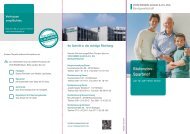2012 Registration document and annual financial report - BNP Paribas
2012 Registration document and annual financial report - BNP Paribas
2012 Registration document and annual financial report - BNP Paribas
- No tags were found...
Create successful ePaper yourself
Turn your PDF publications into a flip-book with our unique Google optimized e-Paper software.
4CONSOLIDATEDFINANCIAL STATEMENTS - YEAR ENDED 31 DECEMBER <strong>2012</strong>Notes to the <strong>financial</strong> statements4Impairment of available-for-sale <strong>financial</strong> assetsImpairment of available-for-sale <strong>financial</strong> assets (which mainly comprisesecurities) is recognised on an individual basis if there is objectiveevidence of impairment as a result of one or more events occurringsince acquisition.In the case of variable-income securities quoted in an active market, thecontrol system identifies securities that may be impaired on a long termbasis <strong>and</strong> is based on criteria such as a significant decline in quotedprice below the acquisition cost or a prolonged decline, which promptsthe Group to carry out an additional individual qualitative analysis. Thismay lead to the recognition of an impairment loss calculated on thebasis of the quoted price.Apart from the identification criteria, the Group has determined threeindications of impairment, one being a significant decline in price, definedas a fall of more than 50% of the acquisition price, another being aprolonged decline over two consecutive years <strong>and</strong> the final one beinga decline on average of at least 30% over an observation period of oneyear. The Group believes that a period of two years is what is necessaryfor a moderate decline in price below the purchase cost to be consideredas something more than just the effect of r<strong>and</strong>om volatility inherent inthe stock markets or a cyclical change lasting a few years, but whichrepresents a lasting phenomenon justifying an impairment.A similar method is applied for variable-income securities not quotedin an active market. Any impairment is then determined based on themodel value.In the case of fixed-income securities, impairment is assessed based onthe same criteria applied to individually impaired loans <strong>and</strong> receivables.For securities quoted in an active market, impairment is determinedbased on the quoted price. For all the others, it is determined based onmodel value.Impairment losses taken against variable-income securities arerecognised as a component of Revenues on the line “Net gain/loss onavailable-for-sale <strong>financial</strong> assets”, <strong>and</strong> may not be reversed through theprofit <strong>and</strong> loss account until these securities are sold. Any subsequentdecline in fair value constitutes an additional impairment loss, recognisedin the profit <strong>and</strong> loss account.Impairment losses taken against fixed-income securities are recognisedunder “Cost of risk”, <strong>and</strong> may be reversed through the profit <strong>and</strong> lossaccount in the event of an increase in fair value that relates objectivelyto an event occurring after the last impairment was recognised.Restructuring of assets classified as “loans <strong>and</strong>receivables”The restructuring of an asset classified in loans <strong>and</strong> receivables isconsidered to be a troubled debt restructuring when the Bank, foreconomic or legal reasons related to the borrower’s <strong>financial</strong> difficulties,agrees to a modification of terms of the original transaction that it wouldnot otherwise consider, resulting in the borrower’s contractual obligationto the Bank, measured at present value, being reduced compared withthe original terms.At the time of restructuring, a discount is applied to the loan to reduceits carrying amount to the present value of the new expected future cashflows discounted at the original effective interest rate.The decrease in the asset value is recognised in profit <strong>and</strong> loss under“Cost of risk”.When the restructuring consists of a partial or full settlement with othersubstantially different assets, the original debt (see note 1.c.14) <strong>and</strong> theassets received in settlement are recognised at their fair value on thesettlement date. The difference in value is recognised in profit or lossunder “Cost of risk”.1.c.6Reclassification of <strong>financial</strong> assetsThe only authorised reclassifications of <strong>financial</strong> assets are the following:■ for a non-derivative <strong>financial</strong> asset which is no longer held for thepurposes of selling it in the near-term, out of “Financial assets at fairvalue through profit or loss” <strong>and</strong> into:■■“Loans <strong>and</strong> receivables” if the asset meets the definition for thiscategory <strong>and</strong> the Group has the intention <strong>and</strong> ability to hold theasset for the foreseeable future or until maturity, orother categories only under rare circumstances when justified <strong>and</strong>provided that the reclassified assets meet the conditions applicableto the host portfolio;■ out of “Available-for-sale <strong>financial</strong> assets” <strong>and</strong> into:■“Loans <strong>and</strong> receivables” with the same conditions as set out abovefor “Financial assets at fair value through profit or loss,■ “Held-to-maturity <strong>financial</strong> assets,” for assets that have a maturity,or “Financial assets at cost,” for unlisted variable-income assets.Financial assets are reclassified at fair value, or at the value calculatedby a model, on the reclassification date. Any derivatives embedded inthe reclassified <strong>financial</strong> assets are recognised separately <strong>and</strong> changesin fair value are recognised through profit or loss.After reclassification, assets are recognised according to the provisionsapplied to the host portfolio. The transfer price on the reclassificationdate is deemed to be the initial cost of the asset for the purpose ofdetermining any impairment.In the event of reclassification from “available-for-sale <strong>financial</strong> assets”to another category, gains or losses previously recognised through equityare amortised to profit or loss over the residual life of the instrumentusing the effective interest method.Any upward revisions to the estimated recoverable amounts arerecognised through an adjustment to the effective interest rate as of thedate on which the estimate is revised. Downward revisions are recognisedthrough an adjustment to the <strong>financial</strong> asset’s carrying amount.1.c.7Issues of debt securitiesFinancial instruments issued by the Group are qualified as debtinstruments if the Group company issuing the instruments has acontractual obligation to deliver cash or another <strong>financial</strong> asset to theholder of the instrument. The same applies if the Group is required toexchange <strong>financial</strong> assets or <strong>financial</strong> liabilities with another entity underconditions that are potentially unfavourable to the Group, or to deliver avariable number of the Group’s own equity instruments.116<strong>2012</strong> <strong>Registration</strong> <strong>document</strong> <strong>and</strong> <strong>annual</strong> <strong>financial</strong> <strong>report</strong> - <strong>BNP</strong> PARIBAS





